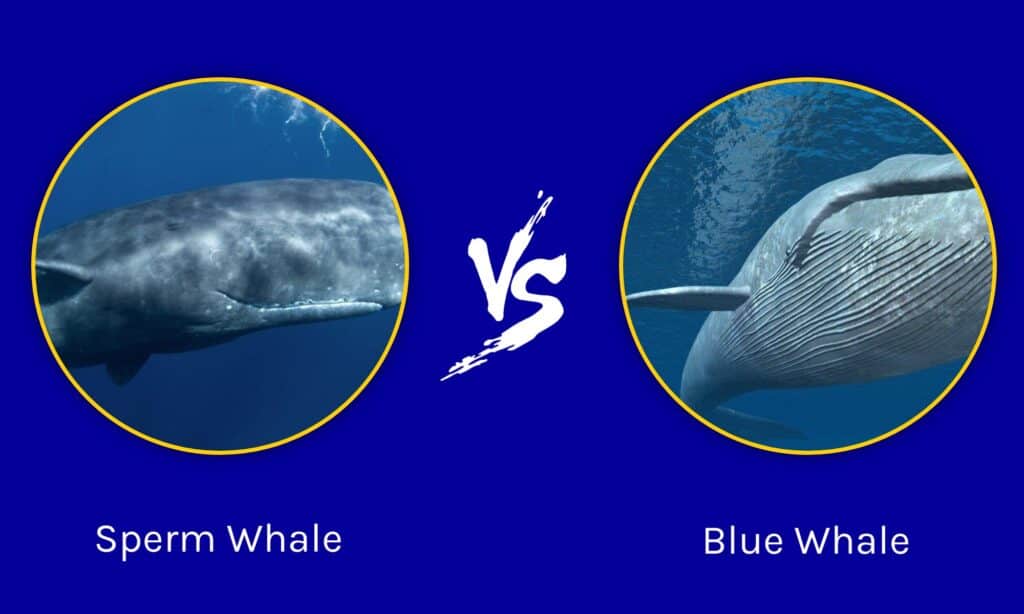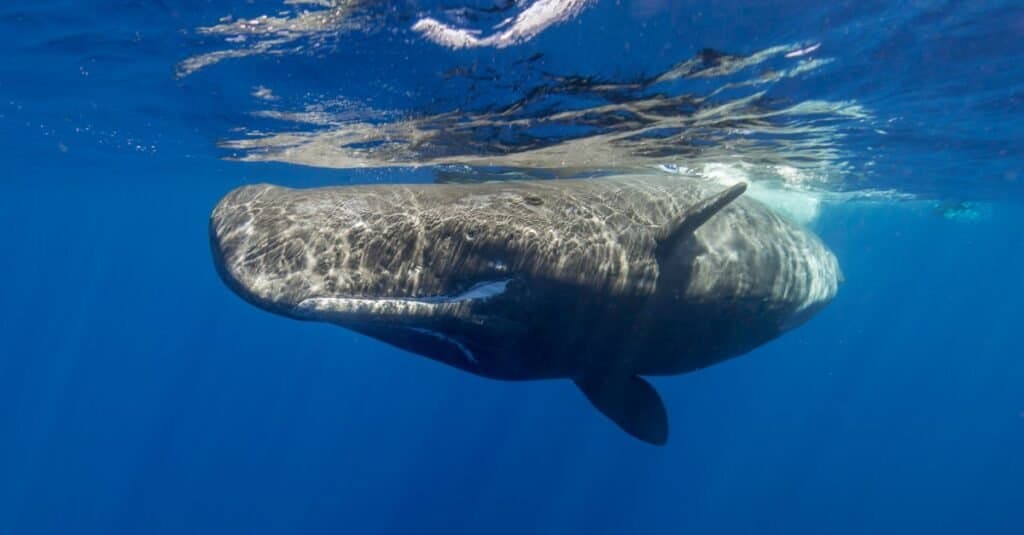Sperm Whales Size Compared to a Blue Whale
Sperm Whale vs Blue Whale: 5 Key Differences
bekirevren/Shutterstock.com
While you may not know all of them currently, there are a great deal of differences separating a sperm whale vs blue whale. What traits do these two beautiful and awe-inspiring creatures share, and what traits classify them as individuals? If you have always wanted to learn more about whales, you're in the right place!
In this article, we will go over sperm whales and blue whales and how they compare and contrast to each other. We will address their appearances and behavioral differences, as well as their preferred habitats and lifespans. That way, you should gain a full understanding of both of these majestic creatures. Let's get started and learn about whales now!
Comparing Sperm Whale vs Blue Whale

A-Z-Animals.com
| Sperm Whale | Blue Whale | |
|---|---|---|
| Size | 50-60 feet long; 35-45 tons | 80-100 feet long; 100-160 tons |
| Appearance | Dark gray body with some white patches; huge and bulbous head with wrinkled skin. Blowhole is asymmetrical and flippers are paddle shaped | Slim and slender body, despite its huge length; dark blue and rubbery skin, with pleats along its throat. Two blowholes in top of head and has a large baleen for eating its unique diet |
| Location and Habitat | Found in oceans around the world, primarily off the coasts of Alaska, the Pacific Islands, and New England | Found in both cold and tropical oceans, depending on the species. Migrates twice a year on average, and can be found off the coasts of North Atlantic and Pacific seas |
| Diet | Fish, sharks, squid, skates, and other sea creatures | Primarily krill, though also eats fish and small crustaceans |
| Lifespan | 30-60 years | 30-45 years |
Key Differences Between Sperm Whale vs Blue Whale

Andrew Sutton/Shutterstock.com
There are many key differences between sperm whales and blue whales. The blue whale grows far larger than the sperm whale, in both length and weight. Additionally, the blue whale is blue in coloration, while the sperm whale is gray in coloration. Finally, the sperm whale lives a slightly longer lifespan compared to the average blue whale.
Let's discuss all of these differences in more detail now.
Sperm Whale vs Blue Whale: Size

wildestanimal/Shutterstock.com
There are some significant differences in the size of the average blue whale versus the size of the average sperm whale. In both length and weight, the blue whale reigns supreme over the average sperm whale. But by how much? Let's take a closer look at the figures now.
Depending on gender and age, the average blue whale reaches anywhere from 80 to 100 feet in length, while the average sperm whale only reaches 50-60 feet in length. Additionally, the sperm whale is an average of 35-45 tons in weight, while the blue whale frequently reaches 100-160 tons in weight. This is a pretty significant difference between the two creatures, and it plays into their overall appearances as well. Let's talk more about this.
Sperm Whale vs Blue Whale: Appearance

Wild_and_free_naturephoto/Shutterstock.com
You can tell some significant physical differences between the sperm whale and the blue whale just by looking at them. Not only are these two whales dramatically different sizes, they are also different colors. For example, the sperm whale has dark to light gray covering, while the blue whale comes in different shades of blue. But this is not the only physical difference between them. Let's talk more about this now.
For example, the head of the sperm whale is much more bulbous and large compared to the head of the blue whale. In addition, the body shape of the blue whale is much longer and more slender compared to the large and well-proportioned body of the sperm whale. The blue whale also has large ridges along its throat and mouth, while the gray whale does not have this feature. Finally, the sperm whale has one asymmetrical blowhole, while blue whales have two blowholes.
Sperm Whale vs Blue Whale: Location and Habitat

wildestanimal/Shutterstock.com
There are some differences in the locations and habitat preferences of the sperm whale and a blue whale. While both of these whales are found throughout all oceans around the world, they have specific places they prefer to spend their time in. For example, the blue whale migrates once or twice a year on average, while some sperm whales do not do this regularly.
You can find blue whales in both cold and temperate seas, depending on the time of the year and the gender of the whale, while sperm whales are primarily found off the coast of Alaska, the Pacific Islands, and New England. If you're interested in whale watching, paying attention to the migratory habits of both of these beautiful creatures will ensure your success!
Sperm Whale vs Blue Whale: Diet

bekirevren/Shutterstock.com
There are some significant differences in the diet of the sperm whale versus the diet of the blue whale. The blue whale is a baleen type of whale, which means it uses a large baleen in which to feed, while the sperm whale has teeth. This means that the sperm whale typically eats fish, squid, sharks, and other creatures, while the blue whale primarily eats krill and the occasional fish.
Sperm Whale vs Blue Whale: Lifespan

wildestanimal/Shutterstock.com
A final potential difference between the sperm whale and the blue whale has to do with their life spans. Overall, the sperm whale lives a longer life on average compared to the blue whale. For example, the average blue whale lives anywhere from 30 to 45 years, while the average sperm whale lives anywhere from 30 to 60 years. However, there are a lot of factors that go into the lifespan of the average whale, so this is something to keep in mind as you do your own research!
More from A-Z Animals
flinchumstren1944.blogspot.com
Source: https://a-z-animals.com/blog/sperm-whale-vs-blue-whale/#:~:text=Depending%20on%20gender%20and%20age,100%2D160%20tons%20in%20weight.
Post a Comment for "Sperm Whales Size Compared to a Blue Whale"